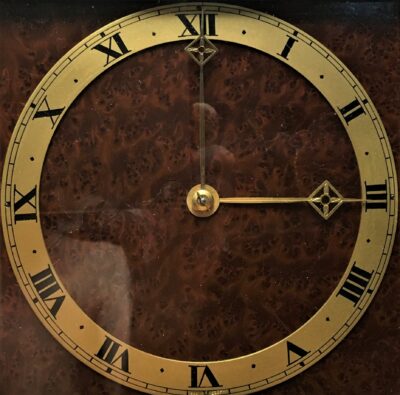Last Update: 07-25-2022 @ 10:50
3.08.1 – The Highlights
According to The International Dictionary of Clocks (1996), the history of Dutch watchmaking is intimately linked to trade with other European countries. Thus, the style and technology of Dutch clocks were influenced by France, reflected in the clocks manufactured in The Hague at the end of the 17th century and Amsterdam’s floor and table clocks in the second half of the 18th century. The English influence was felt in Zeeland and Amsterdam’s clocks in the first half of the 18th century.
- The major clock production centers in Holland in the 17th century were in different major cities such as Amsterdam, Leyden, The Hague, Rotterdam, and Utrecht, but also smaller ones such as Zaandam (north of Amsterdam), Almelo, Eindhoven, and Laren where the Rumpol, father, and son produced wall clocks in the 18th century.
- The clock that has been successful because of its low price is the ‘Frisonne’ or Friesian, produced from the 16th century until 1880 in several cities in the region of Friese hence its name, an officially bilingual region of Holland where Frison and Dutch are spoken. There were still two clock manufacturers left in 1923.
- Clocks were also made in Groningen in the style of the Friesian.
For more details, consult this excellent article on The Dutch Connection.
3.08.2 – Famous Dutch Clockmakers
COSTER, Solomon (c. 1620-1659)
Solomon Coster is a native of The Hague. He was the first Dutch watchmaker to make a clock based on the model of Christian Huygens, which he signed “Samuel Coster, Haghe, met privilege 1657”, thus with his permission. John Fromenteel worked with Coster, which allowed him to build clocks on the Huygens model after a contract was signed between them in 1657.
FROMANTEEL, Ahasuerus II (1640-1703)
Ahasuerus Fromanteel is the son of the Englishman Ahasuerus I. He moved to Amsterdam with his brother John in 1680. He advertised himself as “The English Clockmaker on the Dam.” He produced beautiful floor clocks.
HUYGHENS, Christian (1629-1695)
Christian Huygens is a mathematician and author of Horologium Oscillatorium, Paris, 1673. He is credited with the first application of the pendulum to clocks.
KESSELS, Hendrik Johan (1781-1849)
Hendrik Johan Kessels is the son of a cabinetmaker, born in Maastricht. He drew tower clocks at an early age. In 1807 he was in Denmark, where he worked with a watchmaker in Altona, specializing in chronometers. He also trained in watchmaking in Copenhagen and London. From 1815 to 1821, he worked with Abraham Louis Breguet in Paris. He made multiple clocks and watches, including the movement of a table chronometer signed by Breguet with the words “La Partie Chronométrique par Kessels 1312” (“The Chronometric Part by Kessels 1312”). In 1821, he opened a precision watch manufacturing company in Altona, Denmark. The company would later become Theodor Knoblich, which closed in 1991. He developed numerous marine chronometers, clocks, and pendulums for astronomical observation during his lifetime.
RUEMPOL, Gosselick Hendriks (c. 1682-1759)
Hendricks Gosselick Ruempol’s movements were very sturdy. The dial of his clocks, mostly wall clocks, was almost square with a bronze pediment at the top. The movement was enclosed in a box with a steep two-sided roof. His son Hendrik (1730-1796) also made clocks.
VISBACH, Pieter (c. 1633-1722)
Pieter Visbach was born in The Hague. In 1646, he became an apprentice to Salomon Coster for six years. In 1652, he came to Middelburg, the capital of Zeeland province, and worked with Adam Oosterwijck. At the death of Coster in 1659, he returned to The Hague and took over its trade from his window. He then took an apprentice. For the next 30 years, he became the most prominent clockmaker in The Hague. The Hague Clockmakers Gilde was founded in 1688, and he became its first master.
3.08.3 – Dutch Clock manufacturers
DE VRIES
De Vries was founded in Joure, Friesland, more than 200 years ago by the father of the two brothers of Vries, who took over in 1946 and continued to manufacture Kantooklok, Schippertjes, and Stoelklok clocks on which their names are inscribed. The production nowadays is artisanal and in a minimal volume.
FRANCISCUS CORNELIUS DE JONG
Franciscus Cornelius de Jong was a clock manufacturer from Amsterdam who worked from 1828 to 1876. He is said to have developed a central time system for the city of Amsterdam in 1866.
HANDELSONDERNEMING GEBR BERTRAMS c/o PAUL FRANZ CHRISTIANN SLERHUIS (Gebr Bertrams Trading Company…)
Handelsonderneming Gebr Bertrams was manufacturing alarm clocks in Amsterdam for domestic use. It was registered on November 8, 1957. On February 26, 1958, it registered the ECHO trademark with the U. S. Trademark and Patent Office. We lost track of it.
ORFAC KLOKEN
Freise Orfac created this small company in the 1960s in Roden, now part of the municipality of Noordenveld, province of Drenthe. The factory was located on Kanaalstraat. They made cases from mantle to floor in which they installed Kieninger and Hermle German movement. They cease operations in the 1990s.
WARMINK UURWERKEN EN BAROMETERS ALMELO (WUBA)
Founded in 1929 by John Warminck and based in Almelo, Warmink Uurwerken en Barometers Almelo manufactured Dutch-style clocks under the trademark WUBA until 2004, such as the Zaandam/Zaanse, Sallender, Friesland, and Frisian Schippertje. These clocks are still available on online sites, such as one of this Dutch company that seeks to perpetuate the tradition of Dutch clocks. The Dutch Clocks in North Brabant in the south of the Netherlands sells restored used antique and vintage clocks, including Warminck clocks.
WILLIAM RIKKERS HANDELSONDERNEMING, N. V. (WILLIAM RIKKERS SPECIALTY TRADE INC.)
William Rikkers Handelsonderneming, N. V. was a watches, clocks, and movements production company in business in Amsterdam since 1960.
Next: 3.09 – Clockmaking in Sweden


